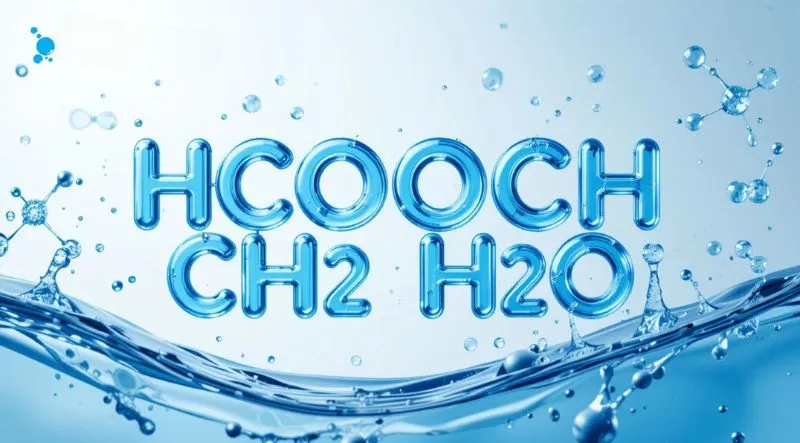In the vast world of organic chemistry, molecules like HCOOCH CH2 H2O can seem complex, yet they serve crucial functions in various chemical and industrial contexts. Though not as commonly discussed as everyday compounds, this molecule plays an essential role in fields like synthesis, catalysis, and solvent systems. This article will unpack what HCOOCH CH2 H2O represents, how it’s structured, its properties, applications, and what makes it chemically intriguing.
Let’s break it down. The compound appears to be a combination involving formate esters and possibly hydrated molecules, which opens up a world of interesting reactivity. When scientists analyze such compounds, they consider not just molecular weights and formulas, but the behavior of each component under different physical and chemical conditions.
What is HCOOCH CH2 H2O?
At a glance, HCOOCH CH2 H2O might appear confusing due to its format, but it suggests a compound composed of a formate group (HCOO-), a methyl or methylene bridge (CH2), and a water molecule (H2O). The arrangement hints at a possible ester (HCOOCH) connected to a CH2 moiety and hydrated via a water molecule, perhaps indicating a hydrated ester or an intermediate form in chemical reactions.
While the exact structural name may vary based on interpretation, this configuration points toward a molecule participating in esterification, hydrolysis, or aqueous-based reactions. These types of molecules are typically reactive in organic chemistry and can be precursors or byproducts in synthetic processes.
Structural Properties of HCOOCH CH2 H2O
The structure of HCOOCH CH2 H2O is indicative of a molecule with polar characteristics. The formate group provides oxygen atoms capable of hydrogen bonding, which makes the molecule soluble in polar solvents like water and alcohols. The CH2 group serves as a bridge, possibly increasing flexibility and enabling further reaction or structural modifications.
The water molecule (H2O) plays a significant role. In many cases, molecules such as this may exist as hydrates, meaning the water is not covalently bonded but rather included in the crystal lattice or as part of a reversible equilibrium system in solution. In other cases, the water may participate in hydrolysis, cleaving ester bonds or acting as a nucleophile in substitution reactions.
Chemical Reactions Involving HCOOCH CH2 H2O
One of the most interesting aspects of HCOOCH CH2 H2O is how it behaves during chemical reactions. Given its components, it’s likely involved in the following types of reactions:
-
Hydrolysis: The ester component (HCOOCH) can undergo hydrolysis in the presence of water, breaking down into formic acid (HCOOH) and alcohols or aldehydes, depending on the other constituents. The H2O in HCOOCH CH2 H2O may act as the reactive agent in this process.
-
Esterification: Under acidic or enzymatic conditions, formic acid and alcohols can recombine to form esters, with HCOOCH CH2 H2O potentially acting as an intermediate.
-
Solvolysis: In certain solvents, especially aqueous systems, the molecule may undergo solvolysis reactions—where the solvent molecules participate directly in the reaction, again utilizing the water content.
In synthesis labs, molecules like HCOOCH CH2 H2O can be useful due to these behaviors. Their reactivity with water means they’re often used in controlled hydrolytic environments or as intermediates in ester-related pathways.
Industrial and Laboratory Uses
Even though HCOOCH CH2 H2O may not be a commercial name per se, its structural components point toward a variety of applications in different industries. For example:
-
Pharmaceutical Synthesis: Formate esters and hydrated derivatives are commonly used in the synthesis of drugs and biologically active molecules. HCOOCH CH2 H2O could serve as a precursor or intermediate in multi-step organic syntheses.
-
Solvent Systems: The presence of a water molecule makes it a candidate for aqueous reactions or as a reagent in solvent mixtures, especially in environmentally conscious or “green” chemistry approaches.
-
Polymer Chemistry: Some hydrated esters play roles in polymerization reactions or act as plasticizers. The flexibility and reactivity of molecules like HCOOCH CH2 H2O make them useful for designing functional materials.
-
Catalytic Pathways: Esters such as these are often employed in catalysis research, especially in enzyme catalysis or metal-organic frameworks where the hydration can significantly affect catalytic efficiency.
Safety and Handling of HCOOCH CH2 H2O
Due to the ester and potential acid formation properties, compounds like HCOOCH CH2 H2O must be handled with caution. If the molecule decomposes or hydrolyzes to formic acid, it may become corrosive and potentially irritating to skin and eyes.
Laboratory handling should include:
-
Use of gloves and safety goggles
-
Working in a fume hood
-
Proper labeling and storage in cool, dry conditions
It’s also important to verify the stability of HCOOCH CH2 H2O under your experimental conditions, as heat or acid/base exposure can drastically alter its behavior.
The Future of Research Involving HCOOCH CH2 H2O
Chemical researchers are constantly exploring new ways to utilize small, reactive molecules like HCOOCH CH2 H2O in advanced synthesis. As green chemistry continues to push for safer, more sustainable chemical processes, esters that naturally interact with water or that are water-soluble become more valuable. The reversible nature of reactions involving HCOOCH CH2 H2O also makes it an attractive candidate for biochemical cycles or sensor development where equilibrium behavior is key.
In fields such as analytical chemistry, tracking the transformations of this molecule could reveal pathways for efficient catalysis or reaction optimization. Additionally, due to its simple structure, it’s also a useful teaching compound for demonstrating concepts like esterification, hydrolysis, and solvation dynamics in academic settings.
Conclusion
To the untrained eye, HCOOCH CH2 H2O might seem like just another chemical formula, but beneath the surface lies a world of dynamic reactivity and industrial significance. From hydrolysis reactions and synthesis applications to solvent behavior and catalysis, this molecule or its derivatives offer a rich field of exploration. Its interaction with water especially highlights how hydration states can influence reactivity, solubility, and overall chemical performance. As science moves toward sustainable chemistry, compounds like HCOOCH CH2 H2O that exhibit versatility and reactivity in water-based systems will remain at the forefront of innovation.

Leave a Reply